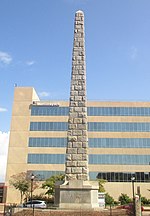Wortham Center for the Performing Arts
Buildings and structures in Asheville, North CarolinaTourist attractions in Asheville, North Carolina
The Wortham Center for the Performing Arts, formerly known as the Diana Wortham Theatre, is a 28,000 square foot (2,600 m2) theater in Pack Place in Asheville, North Carolina. The main 500-seat Proscenium theater opened July 4, 1992 has about 50 shows each season between September and May, plus more than 100 events presented by groups that rent the space.
Excerpt from the Wikipedia article Wortham Center for the Performing Arts (License: CC BY-SA 3.0, Authors).Wortham Center for the Performing Arts
Biltmore Avenue, Asheville
Geographical coordinates (GPS) Address Nearby Places Show on map
Geographical coordinates (GPS)
| Latitude | Longitude |
|---|---|
| N 35.59434 ° | E -82.55112 ° |
Address
White Duck Taco
Biltmore Avenue 12
28801 Asheville
North Carolina, United States
Open on Google Maps










